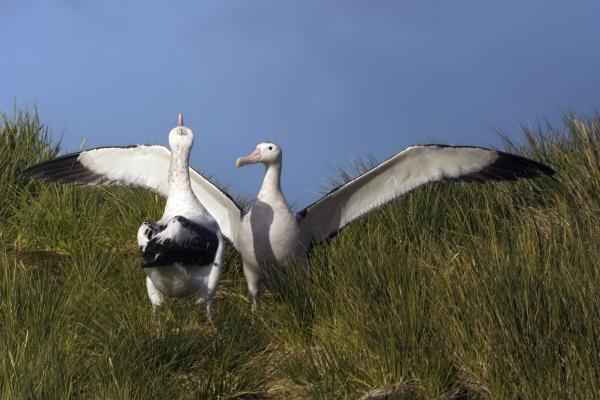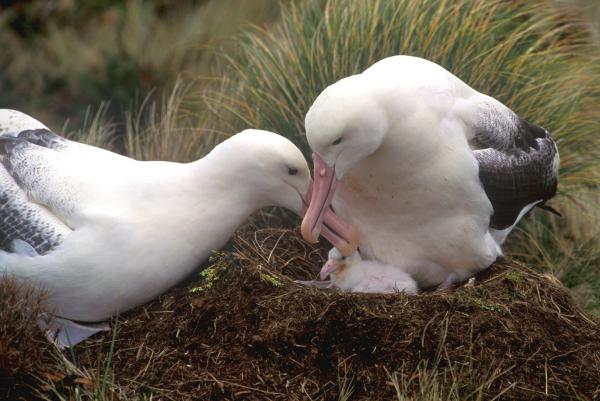The wandering albatross (Diomedea exulans) is not only the largest seabird in the world by wingspan but also a legendary symbol of ocean exploration and endurance. With their vast wings, these birds glide effortlessly over the open ocean for hours or even days on end. In this article, we’ll explore the main features of the wandering albatross, where it is found, its feeding habits, breeding behavior, and conservation status—helping you understand why this majestic bird has captivated sailors and nature lovers for centuries.

Enormous Size: Adult wandering albatrosses measure between 107 and 135 centimeters (about 42–53 inches) in body length, and have a record-breaking wingspan of 254 to 363 centimeters (8.3–11.9 feet), making it the bird with the largest wingspan in the world. Adults typically weigh around 9 kilograms (20 lbs).
Plumage Changes with Age: Juveniles have dark feathers, but as they age, their plumage turns white. Mature adults display mostly white bodies, with black edges on the wings and tail tips.
Large, Powerful Bill: Their large, yellowish beak is covered with horny plates—ideal for grasping slippery marine prey.
Unmatched Flight Ability: Their vast wings allow them to glide for hours with little energy, traveling up to 1,000 kilometers (620 miles) without flapping. Some have been recorded flying for up to 46 days and covering 1,600 kilometers (1,000 miles) without touching land. Juveniles may spend as much as six years at sea before returning to land to breed.
Wind Exploitation: They take advantage of the westerly winds and changing altitudes to cover great distances, even launching themselves from cliffs for easy takeoff.
Strong Link with Humans: Wandering albatrosses are known to follow ships, often becoming companions to sailors on long sea journeys.

Distribution: These albatrosses are found soaring over the Southern Ocean, around Antarctica and the sub-Antarctic seas.
Breeding Sites: They come to land only to breed, choosing remote sub-Antarctic islands such as the Crozet Islands and Prince Edward Islands.
Oceanic Life: Adult birds spend almost all of their lives at sea, coming to shore only for breeding.
Diet: The wandering albatross mainly eats squid and fish found at or near the ocean surface. They can only dive to about one meter deep, so most of their food comes from floating or near-surface prey.
Foraging Tactics: They supplement their diet with crustaceans, fish eggs, and even carrion, especially around fishing boats.
Resourceful Feeders: Their large size allows them to intimidate smaller seabirds and even steal their catch.

Infrequent Breeding: These birds breed only once every two years, due to the energy demands of reproduction and chick rearing.
Maturity: Wandering albatrosses start breeding at around 10 years of age.
Breeding Season: Breeding takes place in November, when they construct nests from mud and grass.
Complex Courtship: Their elaborate courtship includes head-bobbing and wing displays. They are mostly monogamous, often keeping the same mate for life.
Reproductive Details: The female lays a single, large egg. Both parents share incubation, alternating shifts of about 10 days each for a total of 78 days.
Chick Rearing: After hatching, the chick is cared for intensively for several weeks, then parents take turns visiting. Fledging and independence take around nine months.

Major Threats: The main threat to wandering albatrosses is longline fishing. Many birds are accidentally caught on baited hooks and drown, causing significant population declines.
Slow Reproduction: Their slow breeding cycle means every adult lost has a significant impact on the population’s ability to recover.
IUCN Status: The wandering albatross is currently listed as "Vulnerable" by the IUCN, with international efforts underway to protect their habitats and regulate harmful fishing practices.
Conservation Measures: Strategies include promoting safer fishing techniques, banning certain dangerous fishing gear, and increasing awareness about seabird conservation.
Bibliography
Soper, T., Scott, D. (2008) Antarctica, a guide to the wildlife. England: Bradt Travel Guides.
Royo, M. (n.d.) Photographic identification guide to seabirds of the South Atlantic. Buenos Aires: Argentine Wildlife Foundation.
animal tags: Albatross
We created this article in conjunction with AI technology, then made sure it was fact-checked and edited by a Animals Top editor.